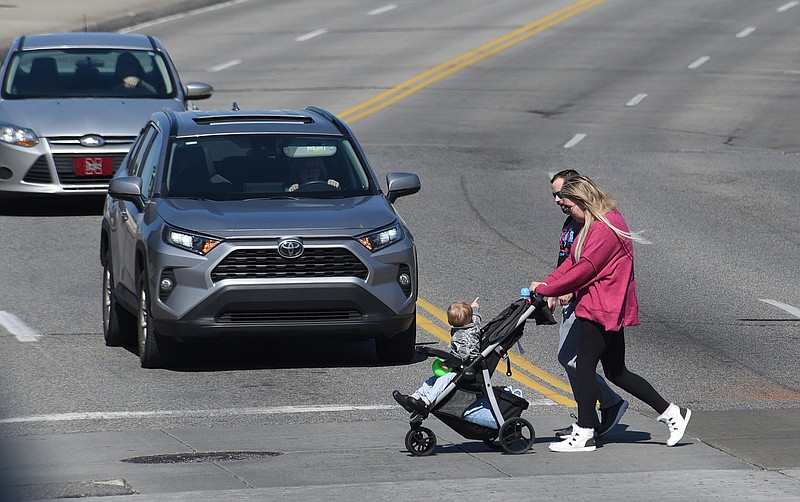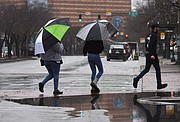ALBUQUERQUE, N.M. - After a festive evening spent viewing a display of holiday lights, Aditya Bhattacharya and his family were crossing a street to head home.
Then a driver blew past a red light, slamming into him and his 7-year-old son, Pronoy.
"I took one step, that's the last thing I remember," said Bhattacharya, 45. "When I regained consciousness, all I could hear was my wife sitting on the sidewalk, screaming, 'Pronoy's dead.'"
The boy's death at an Albuquerque crosswalk in December, and the seven-week manhunt to find the driver, jolted many people in this part of the West to the grim count of pedestrian deaths, which began surging in New Mexico and other states in 2020.
Two years into the pandemic, such fatalities are soaring into record territory amid a nationwide flare-up in reckless driving. In various initiatives to reverse the trends, authorities in one state after another are citing factors from the rise in anxiety levels and pandemic drinking to the fraying of social norms.
Last year, New Mexico recorded 99 pedestrian deaths, up from 81 in 2020 and 83 in 2019 and the most since it began tracking such incidents in the 1990s. But while Sun Belt states have been hit particularly hard, the pedestrian death toll spiked last year in many parts of the country.
New Jersey had its highest number of pedestrian fatalities in more than 30 years. Last year was also the deadliest on Utah's roads since the start of the century, as pedestrian deaths rose 22%. Washington state ended 2021 with a 15-year high in traffic fatalities. And pedestrian deaths in Texas climbed last year to a record high.
Going into the pandemic, some traffic specialists were optimistic that pedestrian deaths would decline. After all, millions of motorists were slashing their driving time and hewing to social distancing measures.
The opposite happened.
Empty roads allowed some to drive much faster than before. Some police chiefs eased enforcement, wary of face-to-face contact. For reasons that psychologists and transit safety experts are just beginning to explain, drivers also seemed to get angrier.
Dr. David Spiegel, director of Stanford Medical School's Center on Stress and Health, said many drivers were grappling with what he calls "salience saturation."
"We're so saturated with fears about the virus and what it's going to do," Spiegel said. "People feel that they get a pass on other threats."
Spiegel said another factor was "social disengagement," which deprives people of social contact, a major source of pleasure, support and comfort. Combine that loss with overloading our capacity to gauge risks, Spiegel said, and people are not paying as much attention to driving safely.
"If they do, they don't care about it that much," Spiegel said. "There's the feeling that the rules are suspended and all bets are off."
Crashes killed more than 6,700 pedestrians in 2020, up about 5% from the estimated 6,412 the year before, according to the Governors Highway Safety Association.
Based on another commonly used road safety metric - vehicle miles traveled - the group projected that the pedestrian fatality rate spiked about 21% in 2020 as deaths climbed sharply even though people drove much less that year, the largest ever year-over-year increase. And preliminary data from 2021 indicates yet another increase in the number of pedestrian deaths.
Crashes involving pedestrians in Chattanooga for 2018-2021
While other developed countries have made strides in reducing pedestrian deaths over the last several years, the pandemic has intensified several trends that have pushed the United States in the other direction. Crashes killing pedestrians climbed 46% over the last decade, compared with a 5% increase for all other crashes, according to the Governors Highway Safety Association.
Angie Schmitt, who describes pedestrian deaths as a "silent epidemic" in a new book, said the reasons included an aging population, in which older pedestrians are more vulnerable, and the growth of the Sun Belt region, where cities were designed after World War II to prioritize speed over safety. And ballooning sizes of SUVs and trucks, which have grown heavier with higher front ends, strike people on foot with greater force than before.
Following decades in which traffic fatalities declined in the United States, Schmitt noted that such deaths began climbing in 2009, when smaller sedans still accounted for most vehicles sold.
"Now, about three out of four new vehicles are pickup trucks, vans or SUVs," Schmitt said. "Cars are getting bigger, faster and deadlier."
Others warn that since new vehicles have grown larger and safer for the people inside them, with features like lane-departure warnings and rearview cameras, some drivers are emboldened to dismiss the risks to pedestrians.
"There's a portion of the population that is incredibly frustrated, enraged, and some of that behavior shows up in their driving," said Mark Hallenbeck, director of the Washington State Transportation Center at the University of Washington. "We in our vehicles are given anonymity in this giant metal box around us, and we act out in ways that we wouldn't face to face."
While leaders in Albuquerque and other cities seek fixes, others following pedestrian fatalities around the country are expressing alarm over the endurance of pandemic-related factors.
Art Markman, a cognitive scientist at the University of Texas at Austin, said that roadway emotions partly reflect "two years of having to stop ourselves from doing things that we'd like to do."
"We're all a bit at the end of our rope on things," Markman said. "When you get angry in the car, it generates energy - and how do you dissipate that energy? Well, one way is to put your foot down a little bit more on the accelerator."
This article originally appeared in The New York Times.
At home
Pedestrian-involved crashes and fatalities in Chattanooga2013Crashes: 106Fatalities: 52014Crashes: 116Fatalities: 32015Crashes: 106Fatalities: 82016Crashes: 96Fatalities: 22017Crashes: 118Fatalities: 22018Crashes: 91Fatalities: 72019Crashes: 98Fatalities: 72020Crashes: 85Fatalities: 22021Crashes: 116Fatalities: 5Source: Chattanooga Police Department

